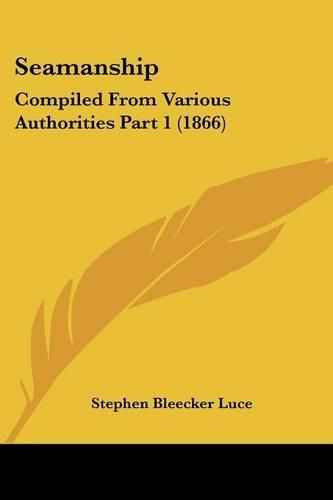Readings Newsletter
Become a Readings Member to make your shopping experience even easier.
Sign in or sign up for free!
You’re not far away from qualifying for FREE standard shipping within Australia
You’ve qualified for FREE standard shipping within Australia
The cart is loading…






Purchase of this book includes free trial access to www.million-books.com where you can read more than a million books for free. This is an OCR edition with typos. Excerpt from book: CHAPTER III. OF THE LOG-LINE AND HALF-MINUTE GLASS. Various methods have been proposed for measuring J;he rate at -which a ship sails; but that most ia use is by the Log and Half-Minute Glass. The Log is a flat piece of thin board, of a sectoral or quad- rantal form, Fig. 220, Kate 25, loaded, on the circular side, with lead sufficient to make it swim upright in the water. To this is fastened a line, about 150 fathoms long, called the log-line, which is divided into certain spaces called knots, and is wound on a reel, Fig. 219, which turns very easily. The Half-Minute Glass is of the same form as an Hour-Glass, Fig. 218, and containing such a quantity of sand as will run through the hole in its neck in lialf a minute of time, or twenty-eight or fourteen seconds. The making of the experiment to find the Telocity of the sliip, is called heaving tJic log, which is thus performed: ?One man holds the reel, and another the half-minute glass; an officer of the watcli throws the log over the ship’s stem, on the lee side, and when he observes the stray line is run off (which is about ten fathoms, this distance being usually allowed to carry the log out of the eddy of the ship’s wake), and the first mark (which is generally a whito rag) is gone off, he cries, Turn; the glass-holder answers, Tarn; and watching the glass, the moment it is run out, says, Up. The reel being immediately stopped, the last mark run off shows the number of knots, and the distance of that mark from the reel is estimated in fathoms. Then the knots and fathoms together show the distance the ship has run the preceding hour, if the wind has been constant. But if the wind has not been the same during the whole hour, or interval of time between heaving the log, or if there has been more sail set or handed, a …
$9.00 standard shipping within Australia
FREE standard shipping within Australia for orders over $100.00
Express & International shipping calculated at checkout
Stock availability can be subject to change without notice. We recommend calling the shop or contacting our online team to check availability of low stock items. Please see our Shopping Online page for more details.
Purchase of this book includes free trial access to www.million-books.com where you can read more than a million books for free. This is an OCR edition with typos. Excerpt from book: CHAPTER III. OF THE LOG-LINE AND HALF-MINUTE GLASS. Various methods have been proposed for measuring J;he rate at -which a ship sails; but that most ia use is by the Log and Half-Minute Glass. The Log is a flat piece of thin board, of a sectoral or quad- rantal form, Fig. 220, Kate 25, loaded, on the circular side, with lead sufficient to make it swim upright in the water. To this is fastened a line, about 150 fathoms long, called the log-line, which is divided into certain spaces called knots, and is wound on a reel, Fig. 219, which turns very easily. The Half-Minute Glass is of the same form as an Hour-Glass, Fig. 218, and containing such a quantity of sand as will run through the hole in its neck in lialf a minute of time, or twenty-eight or fourteen seconds. The making of the experiment to find the Telocity of the sliip, is called heaving tJic log, which is thus performed: ?One man holds the reel, and another the half-minute glass; an officer of the watcli throws the log over the ship’s stem, on the lee side, and when he observes the stray line is run off (which is about ten fathoms, this distance being usually allowed to carry the log out of the eddy of the ship’s wake), and the first mark (which is generally a whito rag) is gone off, he cries, Turn; the glass-holder answers, Tarn; and watching the glass, the moment it is run out, says, Up. The reel being immediately stopped, the last mark run off shows the number of knots, and the distance of that mark from the reel is estimated in fathoms. Then the knots and fathoms together show the distance the ship has run the preceding hour, if the wind has been constant. But if the wind has not been the same during the whole hour, or interval of time between heaving the log, or if there has been more sail set or handed, a …